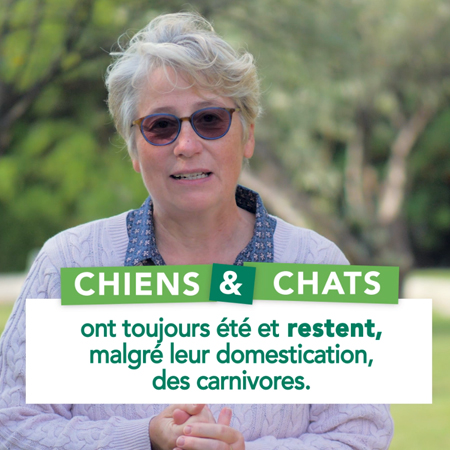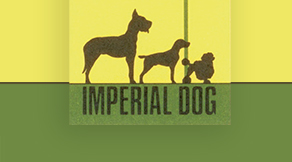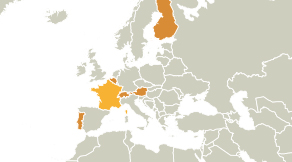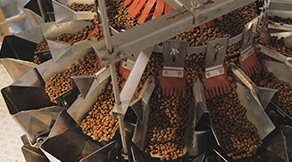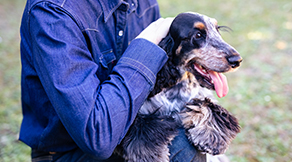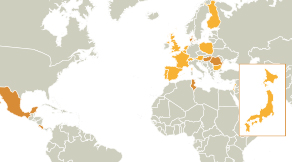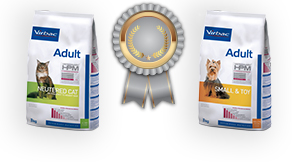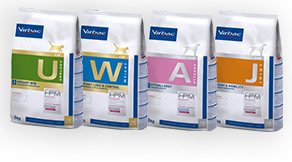
Respecting their carnivorous nature
Despite their domestication, dogs and cats remain carnivores. Their diet must take into account their nutritional needs, specific to their anatomy and physiology.
Despite their domestication, dogs and cats remain carnivores. Recent studies show that a diet rich in animal proteins is perfectly adapted to their anatomy and physiology. Our food respects this fundamental principle.
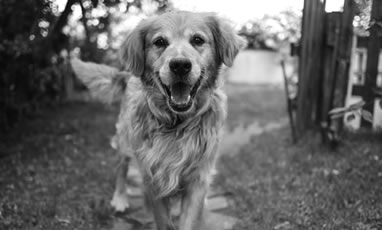
A carnivorous diet favours animal proteins. It corresponds to the taste of the dog and cat, provides them naturally with all the essential nutrients and covers the needs of all the functions of their body, for optimum comfort and quality of life. Beware of vegetarian or vegan diets, which can lead to serious deficiencies and illnesses in carnivores.
A carnivorous diet favours animal proteins and reduces starch as much as possible, which is a source of energy that is poorly used by cats and dogs. It helps maintain muscle mass and mobility, prevents overweight and certain urinary disorders, and contributes to the quality and health of the skin and coat. All these benefits are proven by studies and they are quickly visible.
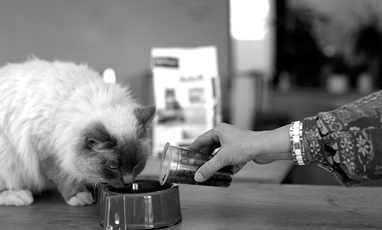
Kibbles are a complete, balanced and easy-to-use food. Contrary to popular belief, dietary changes are not beneficial to dogs and cats. A constant recipe is better adapted to their digestive system and helps prevent imbalances or correct existing disorders... provided that the kibbles are of good quality!
-
![]()
1989
Nutrition for cats and dogs is included in our comprehensive approach to animal health
Convinced that health begins with nutrition, Pierre-Richard Dick, a veterinarian and founder of Virbac, buys Imperial Dog, a manufacturer of physiological food for dogs, in the heart of the Camargue Natural Park, founded by veterinarian Jean Cathary. While animal nutrition across the world often still consists of homemade rations modelled after mankind's nutritional reflexes, we incorporate it into our comprehensive approach to animal health. - 90s
-
![]()
1990
Our dry food takes its place in French veterinary clinics
From the beginning of the 1990s we have had a presence in French veterinary clinics. Practitioners and animal owners discovered Imperial Dog, then Imperial Cat (1997), our first formulae developed to support cats and dogs throughout their lives. A few years later Virbac Consult Diet also saw the light of day, bringing together special formulations for animals with health problems. -
![]()
1997
Animal nutrition the Virbac way has moved beyond the borders of France and is growing in Europe
Expert in health and well-being of cats and dogs, the veterinary practitioner has always been at the heart of our approach to animal nutrition. After French clinics, our foods have been distributed through a veterinary circuit in a growing number of European countries.
1997: Finland
1999: Austria, Portugal and Switzerland
2000: Belgium - The Decade from 2000
-
![]()
2001
Knowledge about animal nutrition is developing, our foods too!
Imperial Dog is giving way to Vet Complex. With Vet Complex 1 Dog (2001) and Vet Complex 1 Cat (2003), our new physiological and dietary recipes are enriched with nutrients which contribute to animal health. Our dietary range of foods thus meet 80% of the health problems of cats and dogs. At the same time, our production teams have been perfecting manufacturing techniques and in 2003, our Camargue production unit was awarded ISO 9001 quality certification. -
![]()
2005
On the ground, success has continued: our food has crossed European borders
Throughout the first decade of the 21st century we continued our expansion in a growing number of European countries. From 2005, our food also arrived in the cat and dog bowls of the Middle East and Asia.
2002: Poland
2003: The Netherlands
2005: Spain, Israel and Japan
2006: Bulgaria
2009: Great Britain and the Lebanon -
![]()
2010
A New Wave of Innovation
We strengthened our team of animal nutrition experts to take further account of the nutritional needs of animals. Everyone is striving to design and develop food with more protein and less carbohydrate. Their commitment and know-how gave birth, five years later, to our new Veterinary HPM® range. - The Decade from 2010
-
![]()
2011
Our Cat and Dog Foods Win Over Latin America
Throughout the decade, animal nutrition the Virbac way continued its development in Europe and arrived in Latin America.
2011: Hungary, Mexico and Costa Rica
2012: Denmark and Romania
2014: Tunisia -
![]()
2015
A key innovation to better meet the nutritional needs of carnivores
After five years of development, we launched Veterinary HPM®, a new physiological nutritional range based on a radically new formulation concept, in the various European countries. Formulated in accordance with the nature of domestic carnivores following a low carbohydrate concept, rich in protein (90% of animal origin), the range offers dog and cat food suitable for their age and size, as well as whether they are sterilised or not. -
![]()
2016
Our Foods Are Popular With Cat and Dog Owners
Veterinary HPM® Adult Small & Toy was tested by the independent organisation and the top consumer association in France, UFC-Que Choisir. It was scored at 16.4/20 and was described as one of the "best choices" among the twenty complete dog foods. In 2017, Veterinary HPM® Adult with Salmon Neutered & Entire Cat in its turn scored 17.5/20, placing it among the "best choices" of the thirteen dry cat foods analysed by the National Institute of Consumption (INC). -
![]()
2017
The Veterinary HPM® Family is Expanding
Drawing on the success of the physiological range, the Veterinary HPM® Family is expanding: a complete dietary range of foods for nutritional purposes now allows us to meet nutritional needs related to specific health disorders, while meeting the requirements of our pets' carnivorous nature. A major advance for their health! - And tomorrow ?


